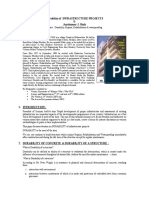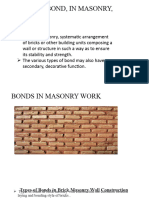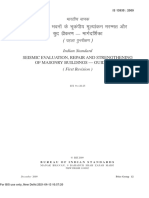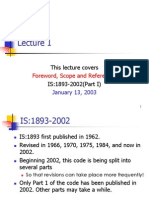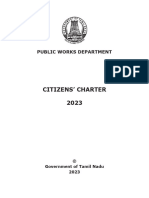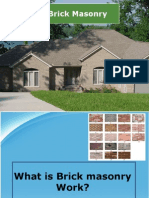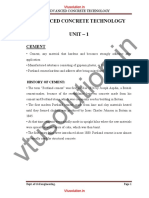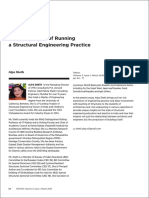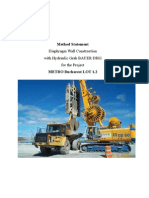100%(2)100% found this document useful (2 votes)
790 viewsDesign of Masonry Structures
The document discusses mortar used in masonry structures. It defines mortar as a workable paste that binds building blocks like bricks and fills gaps between them. Mortar functions as a weaker, sacrificial element compared to building blocks. The document discusses mortar mix proportions, properties of good mortar, importance of water-cement ratios, consistency for different brick sizes, and classifications of cement, lime, and cement-lime mortars.
Uploaded by
Bhushan RaisinghaniCopyright
© © All Rights Reserved
Available Formats
Download as PPTX, PDF, TXT or read online on Scribd
100%(2)100% found this document useful (2 votes)
790 viewsDesign of Masonry Structures
The document discusses mortar used in masonry structures. It defines mortar as a workable paste that binds building blocks like bricks and fills gaps between them. Mortar functions as a weaker, sacrificial element compared to building blocks. The document discusses mortar mix proportions, properties of good mortar, importance of water-cement ratios, consistency for different brick sizes, and classifications of cement, lime, and cement-lime mortars.
Uploaded by
Bhushan RaisinghaniCopyright
© © All Rights Reserved
Available Formats
Download as PPTX, PDF, TXT or read online on Scribd
You are on page 1/ 33
Design of Masonry Structures
(DMS)
(03104380)
Lecture Notes : Mortar for Masonry
Prof. Bhushan Raisinghani
M.Tech by Research – EQRD
Assistant Professor, Department of Civil Engineering - PIET
Mortar
Mortar is a workable paste which dries to bind building blocks
such as stones, bricks, and concrete masonry units.
It is to fill and seal the irregular gaps between them.
Sometimes to add decorative colors or patterns to masonry
walls.
The mortar functions as a weaker component than the building
blocks and serves as the sacrificial element in the masonry.
It creates a water-resistant barrier.
Mortar differs from concrete in working consistencies, methods of
placement and structural performance.
Mortar is binding element while concrete is structural element.
Elective - DMS - 6th semester
The importance of w/c ratio is significant for concrete while
it is less important for mortar.
Mortar has high w/c ratio when mixed but this ratio
changes to lower value when the mortar comes in contact
with the absorbent units.
Mortar mix is not designated by slump or water-cement
ratio. It is the optimum moisture content determined by
the mason.
Mortar that is too dry won’t spread properly which will
result in poor bond and incomplete hydration of the
cement. Too wet mortar will settle quickly and not easy to
trowel.
Elective - DMS - 6th semester
(Bond Test)
Elective - DMS - 6th semester
(Consistency of mortar)
For laying walls with solid bricks 90 to 130 mm
For laying perforated bricks 70 to 80 mm
For filling cavities 130 to 150 mm
Elective - DMS - 6th semester
Features of a good mortar mix ?
Must possess good workability
Mortar have to spread easily
Mortar must easily extrude into the joints
It must stick to the vertical surfaces easily
Permit easy positioning of the unit to line, plumb and the level
The mortar should not allow cracks near the joints and it
should maintain good appearance for longer periods
Uneven mixing of mortar will result in a poor distribution of
cement in areas of the mortar mix and may lead to rain
penetration under certain conditions of severe exposure
Elective - DMS - 6th semester
Important Points ?
The strength of brickwork does not depend on the grade of the mortar used.
When the mortar mix ratio of 1:3 is used for cement to sand or (cement + lime)
to sand ratio, provides a dense mortar with fewer voids.
Even though the strength of lime mortar is less than cement mortar, the
advantages of adding lime in mortar are as follows:
1. Shrinkage in mortar is less, thus less liable to cracks due to shrinkage.
2. Lime increases the workability and plasticity of the mortar mix.
3. Lime has a good water retention capacity and does not evaporate quickly. Also, dry bricks
are not able to suck water from the lime mortar.
4. Lime increases the volume of mortar and fills the voids thus making it water resistant. So,
lime mortar provides more water tightness and resistance against rain penetration.
5. Bonding of lime mortar with bricks is better.
6. Cement-lime mortar is more flexible and can accommodate the normal movements of brick
masonry without cracking. Thus, cement lime mortar, in general, is less liable to cracking
than cement mortar.
Elective - DMS - 6th semester
Cement-lime mortar of leaner mixes from ratio 1:4 to 1:8 tend to be harsh
particularly if sand is coarse and not graded. Hence, plasticizers are recommended
to be used to improve the workability and plasticity of the mortar.
When fineness of sand increases, the workability of the cement-mortar mix
increases, but also increases the surface area of the sand for which requirement
increases for cement and water quantity for the same strength.
Mortar richer than a mix ratio of 1:3 is not used in brickwork masonry construction
because of high shrinkage and no appreciable gain in strength of masonry.
Stresses due to differential movement of masonry due to expansion, contraction
etc. are also reduced by using weak mortar, because weak mortar can easily
accommodate the movements.
Lime-based mortars such as cement-lime mortar or lime mortar give higher
strength of brickwork for the same mortar strength compared to cement mortar.
For example, Cement-sand ratio of 1:6 has mortar strength of 30 kg/cm 2 and
brickwork strength of 5.5 kg/cm2, while cement-lime and the sand-mix ratio of 1:1:6
has mortar strength of 30 kg/cm2 has higher brickwork strength of 7 kg/cm2.
Elective - DMS - 6th semester
Overly thick joints reduce the strength of the brickwork.
Addition of pozzolana increases the strength of the mortar
and makes it more resistant to chemical attacks.
Is Hydrated Lime Necessary?
You don't have to add hydrated lime (calcium hydroxide) to your
mortar mix, but because it can hold more water than cement, it
makes a great binder, ensuring that the sand and cement do not
separate.
Mortar that has lime will last longer, be more pliable (easier to
work with), less brittle, and less prone to cracking and shrinking.
However, the more lime you add, the less compression strength
the mortar will have. The mortar will also dry more slowly.
Elective - DMS - 6th semester
Lime mortar is considered breathable in that it will allow
moisture to freely move through and evaporate from the
surface.
In old buildings with walls that shift over time, cracks can
be found which allow rainwater into the structure.
The lime mortar allows this moisture to escape through
evaporation and keeps the wall dry.
Re−pointing or rendering an old wall with cement mortar
stops the evaporation and can cause problems associated
with moisture behind the cement.
Elective - DMS - 6th semester
Mix Proportions of Mortar (ASTM C270)
Mortar Type Proportions by Volume
Portland
Lime Sand
Cement
M 1 ¼ 3½
S 1 ½ 4½
N 1 1 6
O 1 2 9
K 1 3 12
Elective - DMS - 6th semester
Elective - DMS - 6th semester
Elective - DMS - 6th semester
Elective - DMS - 6th semester
Elective - DMS - 6th semester
Classification of Mortars
Cement Mortar
1. They consist of cement and sand varying in proportion for 1:8 to
1:3.
2. Strength and workability improves by increase in cement
content.
3. Mortar leaner than 1:5 tend to become harsh and unworkable
and are prone to segregation.
4. Cement mortars set early and gain strength quickly.
5. Setting of mortar is by reaction of cement with water and hence
can be used in wet locations.
6. Rich mortars are liable to cracking due to high shrinkage.
Elective - DMS - 6th semester
Classification of Mortars
Lime Mortar
1. Since lime mortars undergo only negligible volume change after setting and
initial shrinkage and the hardening of the mortar is also a slow process, the
mortar is able to retain its bond with the masonry unit and be free from cracks.
2. These consist of intimate mixtures of lime as binder and sand, burnt clay/surkhi,
cinder as fine aggregate in the proportion 1 : 2 to 1 : 3.
3. Lime mortars gain strength slowly and have low ultimate strength.
4. Mortars using hydraulic lime attain somewhat better strength than those using
fat lime. In fact, lime mortars using fat lime do not harden at all in wet locations.
The main advantage of lime mortar lies in its good workability, good water
retentivity and low shrinkage. Masonry in lime mortar has, thus, better resistance
against rain-penetration and is less liable to cracking, though strength is much less
than that of masonry in cement mortar.
Elective - DMS - 6th semester
Classification of Mortars
Cement - Lime Mortar
1. These mortars have the good qualities of cement as well as lime
mortars, that is, medium strength along with good workability,
good water retentivity, freedom from cracks and good
resistance against rainpenetration.
2. Commonly adopted proportions of the mortar (cement : lime :
sand) are
1 : 1 : 6, 1 : 2 : 9 and 1 : 3 : 12.
3. When mix proportion of binder (cement and lime) to sand is
kept as 1 : 3, it gives a very dense mortar since voids of sand
are fully filled.
Elective - DMS - 6th semester
Selection of Mortar Mix
If binder contains more of cement and less of lime, it develops strength
early, and is strong when matured.
A rich cement mortar is needed, firstly, when masonry units of high
strength are used so as to get strong masonry; secondly, when early
strength is necessary for working under frosty conditions; and thirdly,
when masonry is in wet location as in foundation below plinth, where a
dense mortar being less pervious can better resist the effect of soluble
salts.
When strong mortars are not required from considerations of strength
or for working under frosty conditions or for work in wet locations, it is
preferable to use composite mortars of cement, lime and sand, in
appropriate proportions.
Elective - DMS - 6th semester
A mortar with good
water retentivity will
not readily lose water
and stiffen on coming
in contact with masonry
units, and will remain
plastic long enough to
be easily adjusted in
line and level.
This property of good
A workable water retentivity will
mortar will enable the mortar to
hang from develop good bond with
trowel and masonry units and fill
the voids, so that
spread masonry has adequate
easily resistance against rain-
penetration.
Elective - DMS - 6th semester
GRADING CRITERIA OF SAND
IS Sieve % Passing Referen
Designation by mass ce
4.75mm 100 IS 2386
2.36mm 90-100 (Part 1)
1.18mm 70-100
600 micron 40-100
300 micron 5-70
150 micron 0-15
Elective - DMS - 6th semester
Criteria for selection of masonry mortars
In the case of masonry exposed frequently to rains and where there is
further protection by way of plastering or rendering or other finishes, the
grade of mortar shall not be less than MM 0.7 but shall preferably be of
grade MM 2. Where no protection is provided, the grade of mortar for
external walls shall riot be less than MM 2.
In the case of load bearing internal walls, the grade of mortar shall
preferably be MM 0.7 or more for high durability but in no case less than
MM 0.5.
Where soil has little moisture, masonry mortar of grade not less than MM
0.7 shall be used.
Where soil is very damp, masonry mortar of grade preferably MM 2 or more
shall be used. But in no case shall the grade of mortar be less than MM 0.7.
Where soil is saturated with water, masonry mortar of grade MM 3 shall be
used but in no case shall the grade of mortar be less than MM 2.
Elective - DMS - 6th semester
For masonry in buildings’ subject to vibration of machinery,
the grade of mortar shall not be less than MM 3.
For parapets, where the height is greater than thrice the
thickness, the grade of masonry mortar used shall not be less
than MM 3.
The grade of mortar for bedding joints in masonry with large
concrete blocks shall not be less than MM 3.
Elective - DMS - 6th semester
Unit weight of materials in loose condition
Sand – variable
Lime – pozzolana mixture – 700 to 840 g/cu.m
Pozzolana – burnt clay pozzolana 775-945 g/cu.m ; flyash 570-
600 g/cu.m
Dry hydrated lime – 630 to 770 g/cu.m
Elective - DMS - 6th semester
Compressive Strength Test of Mortar
For a load bearing masonry construction, it is important to know
the compressive strength requirement of masonry to withstand
the load subjected on it. A masonry wall is subjected to
compressive loads from floors above it and should have
sufficient strength to withstand it. So, masonry compressive
strength should be enough to support the loads on wall.
7.06cm cubes moulds (50cm2 face area), apparatus for gauging and
mixing mortar, vibrator, compression testing machine etc.
Take 200gm of cement and 600gm of standard sand in the mix ratio
1:3 (by weight) in a pan.
Standard sand shall pass through 2mm IS sieve and shall be retained
on 90 microns IS sieve with the following particle size distribution.
Elective - DMS - 6th semester
Mix the cement and sand in dry condition with a trowel for 1minitues
and then add water. The quantity of water shall be (p/4+3)% of
combined weight of cement and sand where, p is the % of water
required to produce a paste of standard consistency determined earlier.
Add water and mix it until the mixture is of uniform colour. The time of
mixing shall not be < 3 minutes & not > 4 minutes.
The mortar shall be prodded 20 times in about 8 sec to ensure
elimination of entrained air.
Elective - DMS - 6th semester
After 24 hours remove the cubes from the mould and
immediately submerge in clean water till testing.
Take out the cubes from water just before testing.
Testing should be done on their sides without any packing.
The rate of loading should be 350 kg/cm 2/minute and uniform.
Test should be conducted for 3 cubes and report the average
value as the test result for both 7day and 28 day compressive
strength.
Elective - DMS - 6th semester
PRECAUTIONS
The mould should be oiled before use.
The weighing should be done accurately
The temperature and humidity must be accurately controlled
Increase the load gradually during testing.
The cubes should be tested immediately after taking out of
water and not allowed to dry until they fail under testing.
The gauging time should be strictly observed.
The cubes should be tested on their sides and not on their
faces.
Elective - DMS - 6th semester
Compressive strength of mortar in masonry significance,
influences, test methods & requirements, 10th IB2MaC, Canada –
Peter Schubert & Gisbert Hoffmann (1984)
Elective - DMS - 6th semester
LIME vs CEMENT
Sr. No. Lime Cement
Colour While or greyish white Dark grey or greyish brown
Slaking It takes place on adding Hardening takes place on adding
water water
Setting Sets slowly by taking Sets rapidly by addition of water
CO2 from air or by water
Hardening Slow Rapid
Compressi Less High
ve
Strength
Cost Cheap Costly
Use For ordinary construction Most suitable for structural
work purpose because it can be
Elective - DMS - 6th semester
stretched more
FAT LIME vs HYDRAULIC LIME
Sr. Item Fat Lime Hydraulic Lime
No.
1. Composition It is obtained from It is obtained from limestone
comparatively pure carbonate containing clay to the extent of
of lime containing only 5% of about 5-30% and some amount
clayed impurities. of ferrous oxide.
2. Slaking action It slakes vigorously. It slakes slowly.
3. Setting action It sets slowly in presence of air. It sets under water and forms
crystals of hydrated tricalcium
aluminate and dicalcium
silicate.
4. Hydraulicity It does not possess hydraulic It possess hydraulic property.
property.
5. Colour It is perfectly white in colour. Its colour is not so white.
6. Strength It is not very strong. It is strong and can be adopted
where strength is required.
7. Uses It is used for plastering, It is used for preparing mortar
Elective - DMS - 6th semester whitewashing, etc. and for for thick walls, damp places,
REFERENCES
IS 2250 – CODE OF PRACTICE FOR PREPARATION AND USE OF MASONRY MORTARS
IS 712 – SPECIFICATIONS FOR BUILDING LIMES
IS 2116 – SPECIFICATION FOR SAND FOR MASONRY MORTARS
SP 20 -
Elective - DMS - 6th semester
THANK YOU
Q&A
Elective - DMS - 6th semester
You might also like
- Defects in Concrete Structures - Types Causes, Prevention PDF100% (1)Defects in Concrete Structures - Types Causes, Prevention PDF11 pages
- Fire Safety Requirements For Liquefied Petroleum Gas (LPG) Cylinder Installations100% (2)Fire Safety Requirements For Liquefied Petroleum Gas (LPG) Cylinder Installations26 pages
- Graphical Symbol For Marine Piping System PDF100% (2)Graphical Symbol For Marine Piping System PDF18 pages
- Repair Rehabilitation and Retrofitting of Reinforced Concrete Structures IJERTCONV9IS01008100% (1)Repair Rehabilitation and Retrofitting of Reinforced Concrete Structures IJERTCONV9IS010084 pages
- Structural Masonry, 1/e: Book Information Sheet Book Information SheetNo ratings yetStructural Masonry, 1/e: Book Information Sheet Book Information Sheet1 page
- Earthquake Resistent Building ConstructionNo ratings yetEarthquake Resistent Building Construction13 pages
- Analysis and Design of G+7 Storey Residential Building, 2018No ratings yetAnalysis and Design of G+7 Storey Residential Building, 20184 pages
- Repair and Rehabilitation of Concrete StructureNo ratings yetRepair and Rehabilitation of Concrete Structure18 pages
- 4.3 Mix Desgin For M40 Grade STEP-1:-Target Strength of Mixed ProportionNo ratings yet4.3 Mix Desgin For M40 Grade STEP-1:-Target Strength of Mixed Proportion5 pages
- RS3804 - Grade - 9 Construction TechnologyNo ratings yetRS3804 - Grade - 9 Construction Technology62 pages
- Lecture-I Introduction To Concrete Technology100% (4)Lecture-I Introduction To Concrete Technology102 pages
- Rehabilitation and Retrofitting of Structures - Subjective Questions100% (2)Rehabilitation and Retrofitting of Structures - Subjective Questions2 pages
- Types of Bonds in Brick Masonry Wall ConstructionNo ratings yetTypes of Bonds in Brick Masonry Wall Construction28 pages
- Comparision Between Brick and Stone Mansory100% (1)Comparision Between Brick and Stone Mansory1 page
- CE2306 Design of RC Elements Anna University Question Bank Question Paper 2 Marks and 16 MarksNo ratings yetCE2306 Design of RC Elements Anna University Question Bank Question Paper 2 Marks and 16 Marks9 pages
- Is 13935 Seismic Evaluation & Strengthening of Masonry BuildingsNo ratings yetIs 13935 Seismic Evaluation & Strengthening of Masonry Buildings41 pages
- Is 456 2000 Most Expected Questions (Avnish Sir) 30-03-22No ratings yetIs 456 2000 Most Expected Questions (Avnish Sir) 30-03-2235 pages
- Transportation Engineering 2 by Bandana Jethy 2f0390No ratings yetTransportation Engineering 2 by Bandana Jethy 2f0390127 pages
- Earthquake Analysis and Design of Structural100% (2)Earthquake Analysis and Design of Structural15 pages
- 4.2 Continuous Load Path: 4.3 Overall FormNo ratings yet4.2 Continuous Load Path: 4.3 Overall Form10 pages
- 1.15 Destructive Test For Hardened ConcreteNo ratings yet1.15 Destructive Test For Hardened Concrete17 pages
- Rehabilitation and Retrofitting of Structures: PatronNo ratings yetRehabilitation and Retrofitting of Structures: Patron2 pages
- Seismic Analysis of RC Shear Wall in Multi-Storeyed BuildingNo ratings yetSeismic Analysis of RC Shear Wall in Multi-Storeyed Building14 pages
- Choosing The Right Mortar For Your ProjeNo ratings yetChoosing The Right Mortar For Your Proje5 pages
- Lec 6 - Measurement by Approximate Area MethodsNo ratings yetLec 6 - Measurement by Approximate Area Methods19 pages
- Rate Analysis: (Estimation Costing & Valuation)100% (2)Rate Analysis: (Estimation Costing & Valuation)20 pages
- Rate Analysis: (Estimation Costing & Valuation)100% (2)Rate Analysis: (Estimation Costing & Valuation)20 pages
- ASCE 41 - Seismic Rehabilitation of Existing Buildings67% (6)ASCE 41 - Seismic Rehabilitation of Existing Buildings70 pages
- Properties of Malaysian Fired Clay Bricks and Their Evaluation With International Masonry Specifications0% (1)Properties of Malaysian Fired Clay Bricks and Their Evaluation With International Masonry Specifications229 pages
- 5 - SPM LN-11 - 14 - 18 - 25 - 35 - 60 TP - 2015-12No ratings yet5 - SPM LN-11 - 14 - 18 - 25 - 35 - 60 TP - 2015-1235 pages
- Detailed Survey Guide and Audit RequirementsNo ratings yetDetailed Survey Guide and Audit Requirements71 pages
- What Is The Definition of Hardness TestingNo ratings yetWhat Is The Definition of Hardness Testing8 pages
- Me6301 Engineering Thermodynamics - Course Objectives & OutcomesNo ratings yetMe6301 Engineering Thermodynamics - Course Objectives & Outcomes2 pages
- Computational Fluid Dynamics (CFD) Blog - LEAP Australia & New Zealand - Turbulence Part 3 - Selection of Wall Functions and Y - To Best Capture The Turbulent Boundary LayerNo ratings yetComputational Fluid Dynamics (CFD) Blog - LEAP Australia & New Zealand - Turbulence Part 3 - Selection of Wall Functions and Y - To Best Capture The Turbulent Boundary Layer7 pages
- Iqwq-ce1092-Qpqac-00-0001 - 0 -Quality Control Procedure for Civil 土建质量控制程序No ratings yetIqwq-ce1092-Qpqac-00-0001 - 0 -Quality Control Procedure for Civil 土建质量控制程序37 pages
- Bill of Material GE India Industrial PVT LTD: Revision No. Revision Details DateNo ratings yetBill of Material GE India Industrial PVT LTD: Revision No. Revision Details Date7 pages
- Samsung Product Catalogue Commercial 2020 - EnglishNo ratings yetSamsung Product Catalogue Commercial 2020 - English139 pages
- Strength of Single-Phase High-Entropy Carbide Ceramics Up To 2300°CNo ratings yetStrength of Single-Phase High-Entropy Carbide Ceramics Up To 2300°C25 pages
- Domestic and Industrial Water Piping Guide Design100% (1)Domestic and Industrial Water Piping Guide Design7 pages
- Design and Analysis of Vertical Pressure VesselNo ratings yetDesign and Analysis of Vertical Pressure Vessel12 pages
- Manual For Experimental Water Cooling Tower100% (1)Manual For Experimental Water Cooling Tower7 pages
- Defects in Concrete Structures - Types Causes, Prevention PDFDefects in Concrete Structures - Types Causes, Prevention PDF
- Fire Safety Requirements For Liquefied Petroleum Gas (LPG) Cylinder InstallationsFire Safety Requirements For Liquefied Petroleum Gas (LPG) Cylinder Installations
- Repair Rehabilitation and Retrofitting of Reinforced Concrete Structures IJERTCONV9IS01008Repair Rehabilitation and Retrofitting of Reinforced Concrete Structures IJERTCONV9IS01008
- Structural Masonry, 1/e: Book Information Sheet Book Information SheetStructural Masonry, 1/e: Book Information Sheet Book Information Sheet
- Analysis and Design of G+7 Storey Residential Building, 2018Analysis and Design of G+7 Storey Residential Building, 2018
- 4.3 Mix Desgin For M40 Grade STEP-1:-Target Strength of Mixed Proportion4.3 Mix Desgin For M40 Grade STEP-1:-Target Strength of Mixed Proportion
- Rehabilitation and Retrofitting of Structures - Subjective QuestionsRehabilitation and Retrofitting of Structures - Subjective Questions
- CE2306 Design of RC Elements Anna University Question Bank Question Paper 2 Marks and 16 MarksCE2306 Design of RC Elements Anna University Question Bank Question Paper 2 Marks and 16 Marks
- Is 13935 Seismic Evaluation & Strengthening of Masonry BuildingsIs 13935 Seismic Evaluation & Strengthening of Masonry Buildings
- Is 456 2000 Most Expected Questions (Avnish Sir) 30-03-22Is 456 2000 Most Expected Questions (Avnish Sir) 30-03-22
- Transportation Engineering 2 by Bandana Jethy 2f0390Transportation Engineering 2 by Bandana Jethy 2f0390
- Rehabilitation and Retrofitting of Structures: PatronRehabilitation and Retrofitting of Structures: Patron
- Seismic Analysis of RC Shear Wall in Multi-Storeyed BuildingSeismic Analysis of RC Shear Wall in Multi-Storeyed Building
- ASCE 41 - Seismic Rehabilitation of Existing BuildingsASCE 41 - Seismic Rehabilitation of Existing Buildings
- Properties of Malaysian Fired Clay Bricks and Their Evaluation With International Masonry SpecificationsProperties of Malaysian Fired Clay Bricks and Their Evaluation With International Masonry Specifications
- 5 - SPM LN-11 - 14 - 18 - 25 - 35 - 60 TP - 2015-125 - SPM LN-11 - 14 - 18 - 25 - 35 - 60 TP - 2015-12
- Me6301 Engineering Thermodynamics - Course Objectives & OutcomesMe6301 Engineering Thermodynamics - Course Objectives & Outcomes
- Computational Fluid Dynamics (CFD) Blog - LEAP Australia & New Zealand - Turbulence Part 3 - Selection of Wall Functions and Y - To Best Capture The Turbulent Boundary LayerComputational Fluid Dynamics (CFD) Blog - LEAP Australia & New Zealand - Turbulence Part 3 - Selection of Wall Functions and Y - To Best Capture The Turbulent Boundary Layer
- Iqwq-ce1092-Qpqac-00-0001 - 0 -Quality Control Procedure for Civil 土建质量控制程序Iqwq-ce1092-Qpqac-00-0001 - 0 -Quality Control Procedure for Civil 土建质量控制程序
- Bill of Material GE India Industrial PVT LTD: Revision No. Revision Details DateBill of Material GE India Industrial PVT LTD: Revision No. Revision Details Date
- Samsung Product Catalogue Commercial 2020 - EnglishSamsung Product Catalogue Commercial 2020 - English
- Strength of Single-Phase High-Entropy Carbide Ceramics Up To 2300°CStrength of Single-Phase High-Entropy Carbide Ceramics Up To 2300°C


